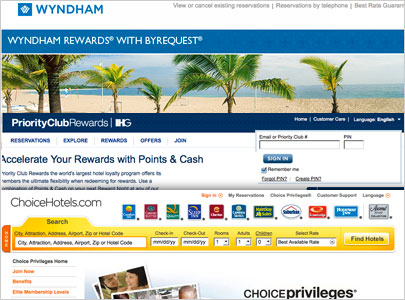
The share of hospitality loyalty program members increased by 13% versus one year ago, contributing to higher overall customer satisfaction scores, according to iPerceptions.
During the economic downturn, many companies invested in their loyalty programs as a means of stimulating immediate bookings and longer-term brand loyalty, said Claude Guay, president and
CEO of Montreal-based iPerceptions, whose clients include InterContinental Hotels, Hyatt, Fairmont, Best Western, Choice Hotels International and Wyndham Worldwide.
“Their efforts have
paid off, as members tend to have more positive Web site experiences than nonmembers, being that they are more familiar with the Web sites, visiting more frequently to make reservations, earn points,
manage their accounts, “ Guay says in a release. “This results in members developing stronger relationships with the brands and exhibiting stronger loyalty over time.”
The share of loyalty program members increased from 66% in Q3 2010 to 79% in Q3 2011. This trend was evident among both business travelers -- whose share of members rose from 80% in Q3 2010 to 90% in
Q3 3010 -- and leisure travelers, whose share of members rose from 63% to 70%.
Overall satisfaction scores increased during the same period, from 71 to 73, due in large part to the
continued growth of loyalty program membership. Most attributes measuring the online experience increased significantly among loyalty program members between third-quarter 2010 and third-quarter 2011,
suggesting that Web sites are doing a better job of meeting members’ needs -- either through site changes or more targeted offers.
Content Relevancy continues to be identified as
the key strength of the hospitality and tourism Web sites, indicating that they excel in providing meaningful, relevant information. Despite the large share of loyalty program members, however, the
Web sites still struggle to convince visitors that they offer the best rates, as determined by comparatively lower scores for the Bottom Line attribute.
Business travelers increased from
24% in Q3 2010 to 27% in Q3 2011, while leisure travelers decreased from 67% to 63%. Leisure travelers who came to make a reservation increased from 31% in Q3 2010 to 33% in Q3 2011. Visitors who did
not complete their reservation because of price increased from 14% in Q3 2011 to 27% in Q3 2011, while those who did not book due to technical problems decreased from 17% to 5%.
The
report analyzed immediate post-experience feedback from more than 130,000 people visiting over 160 hospitality and tourism sites to identify issues and trends facing this unique industry. The data is
international, with the USA representing 52% of the total, Canada 7.7% and the remainder of the world 40.3%. The full report can be found here.
advertisement
advertisement